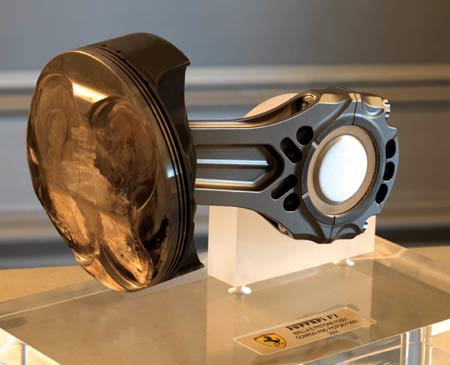The effect of con rod length
Con rods are part of the fundamental mechanism at the heart of almost every race engine in the world, and there is little to make me think that this is about to change. In dealing with the forces exerted on adjacent components by a con rod, we tend to split their mass into a reciprocating component, which we assume travels up and down with the piston, and a rotating component, which we assume travels around with the crankpin on which it operates.
As race engine engineers, we generally take great care to keep both piston assembly mass and crankshaft inertia to a minimum. Something that might seem a very attractive concept, therefore, is to shorten the con rod. Not only would we save mass in the con rod, but the block could be made shorter, reducing the mass of the block and lowering the height of the centre of gravity of the engine. Again, these are all generally laudable aims for a race engine.
However, we find that there are a number of reasons to maintain or increase con rod length. The first of these is the mitigation of secondary forces. These secondary forces act at twice engine speed and are proportional to the ratio of crank throw to rod length. We can see that decreasing this ratio will reduce secondary forces and, with a fixed crank throw, we would look to increase rod length to achieve this.

In the formula above, F is the force due to the reciprocating mass, m is the reciprocating mass, omega is the rotational speed of the engine (radians per second), r is the crankshaft throw, l is the rod length and theta is the angle from TDC. At TDC, cosθ = cos2θ = 1
For a 100 mm rod acting on a crankshaft of 40 mm stroke (20 mm throw), the secondary forces add 20% to the primary force. Where short rods are used, the r/l ratio may be as much as 0.3.
The second reason why short rods are not often used is the effect of rod angularity. The longer the con rod, the lower its angle to the cylinder axis for any angle of crankshaft rotation. The higher the r/l ratio, the greater the angle of the rod when maximum cylinder pressure occurs.
The effect of higher rod angularity is to increase the side load on the piston skirt. For a given coefficient of friction, a higher load means a higher drag on the piston and increased frictional losses. The interaction between the skirt, lubricant film and cylinder wall means the coefficient of friction cannot be assumed to remain constant, but the principle holds true that lower con rod angularity offers lower friction.
There are other ways of achieving this, such as pistons with pin bores that are offset from the piston axis, or engines with cylinder axes offset from the crankshaft axis. Each alternative, however, comes with its own difficulties and complexity of design. A longer con rod is often compatible with all existing components, and unlike offset engine layouts, the crankshaft stroke and piston stroke remain identical.

Fig. 1 - Even where low mass is most highly prized, using the shortest rod possible isn't necessarily the preferred option
Written by Wayne Ward